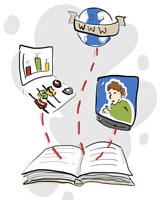Pattern: Online Materials as Supplements to Scripts and Textbooks

Context/Setting
A textbook, printed script, or scanned print templates form the content basis for a course.
Problem Statement
Structural features, presentation forms, and methodological approaches that go beyond linear text with illustrations are difficult to realize in printed texts or digital print templates. Furthermore, current changes, examples, and references cannot be incorporated into traditional text media or only with considerable effort.
Area of Tension
Instructor vs. authors of the texts (if not the same person); diversity of students: different learning styles and online affinity.
Solution
Multimedia learning materials on a teaching/learning platform are available as a supplement to conventional teaching texts. Alternatively, an instructional text can be prepared and enriched digitally from the start.
Details
The instructional text is prepared as a structured "hyper-textbook":
- Text with illustrations can be enriched with videos and audios (e.g., interviews from YouTube or public service media libraries) and possibly animations or simulations;
- References to external learning content or websites allow learners to engage with multiple forms of didactic preparation, adopt different perspectives, or recognize practical connections;
- Cross-references and an embedded glossary within the text provide additional reception opportunities;
- In five-to-ten-minute videos, the instructor can give introductions to the content of topic areas and explain assessments;
- Self-tests and case studies with sample solutions can sensibly round out the offerings (see the didactic design pattern of online self-tests and practice exams).
Pitfalls
The multimedia learning materials must truly offer added value to the students. The ratio of effort to benefit must be balanced.
If it continues to predominantly be text, it should be divided into sections with subheadings, displayed on screen in medium-sized font, and not in overly wide columns. Additionally, the entire text should be downloadable (and thus readable offline) and printable.
Offers for purely receptive learning in self-study should be complemented by instructors with tools and binding methods for communication and collaboration.
Advantages
Multimedia learning materials can support various learning styles. Content can be presented more diversely and illustratively. A decisive didactic advantage can arise if students are able to manipulate learning objects, such as simulations.
Examples
A freely accessible OLAT course on a newly published textbook about a young specialization in business administration with strong practical relevance, here: the importance and peculiarities of so-called nonprofit organizations. The course includes videos with introductory explanations by the authors for each chapter; also, self-tests, case studies with sample solutions, and references to external websites, videos, and audios.
Tools
- Wiki (OLAT, CommSy)
- ONYX for self-tests
Related Patterns
Online self-tests and practice exams
